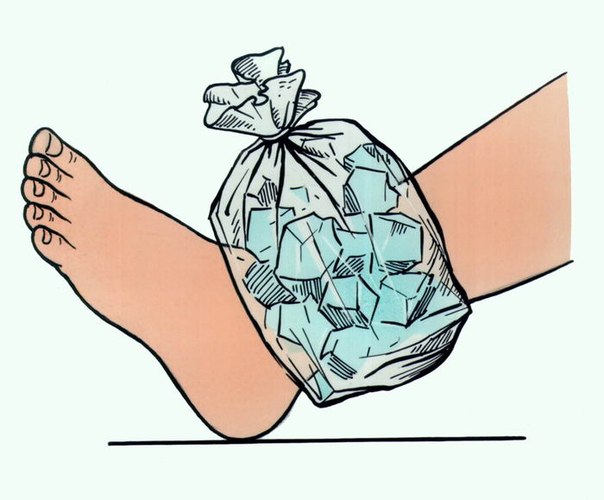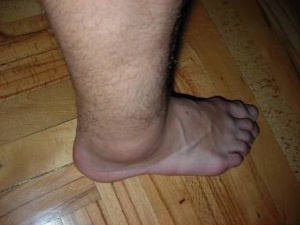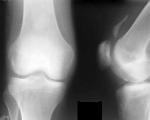Ankle fracture in the presence of displacement is a serious injury that requires serious treatment
Fracture of the ankle is not uncommon in traumatology practice. Such cases become especially frequent during ice, when people's feet are unstable in relation to the road.
One awkward movement, an incorrectly set leg - and a fracture can occur. And this is a painful and long treatment and no less long rehabilitation.
They are open and closed, a fracture of the inner or outer ankle, or a displaced ankle fracture. All of them have different manifestations, but there are symptoms that generalize them:

All signs of a fracture appear almost instantly. If they are very pronounced, then you should immediately send the victim to the hospital.
Severe ankle fractures reveal the following signs: the patient becomes very pale (nerves and blood vessels are affected), the foot becomes numb and its deformity is clearly visible, bone fragments can break through the skin and come out, profuse bleeding.
When a displaced fracture of the external ankle occurs, the following symptoms appear:
- sharp pain;
- the lower leg is very swollen;
- it is impossible to move the leg, unbend and bend it in the joint, and even more so to stand on the leg. If such a fracture is without displacement, then a person can still do some movements with the injured leg.
With a closed fracture of the external ankle, there is such a sign: you need to press on the middle of the lower leg and pain will appear at the fracture site.
With a fracture of the medial malleolus with displacement, the following symptoms are noted:
- also sharp pain and great swelling of the damaged joint, a hematoma appears after a few hours;
- impossibility of independent movement;
- the victim cannot lean on the injured leg.
In both cases, the lower leg looks unnaturally everted. How much to wear a cast depends on the type of fracture.
First aid
If, after an injury, the victim has signs characteristic of an ankle fracture, then assistance should be provided immediately.
In cases where it is untimely or rendered incorrectly, a fracture can have serious consequences. For example, the inept actions of someone who tried to provide first aid can translate a closed fracture into an open fracture.

You need to act quickly, but carefully so as not to cause additional trouble:
- remove the shoes from the injured leg, otherwise, after the development of edema, it will have to be cut.
- gently lift your leg and place something folded into a small roller under it.
- with a closed fracture, cold should be applied to the sore spot.
- if the pain is severe, give an anesthetic tablet.
- if the fracture is open, immediately arrange for the transfer of the victim to the hospital. But first you need to stop the bleeding by applying a tourniquet above the injury. You must tell the doctor how much time has passed since the tourniquet was applied. Never touch the bone fragments and do not try to put them back in place or remove them from the wound. This is dangerous! Only a doctor can do such manipulations.
Do not give the patient food or drink, as anesthesia may soon be needed. The leg must be immobilized using an impromptu splint, which is applied on both sides and bandaged.
Treatment
Treatment of a displaced ankle fracture is carried out only during hospitalization. How long it will last depends on the choice of treatment tactics. Two methods of treatment can be applied: conservative and surgical. The goal of treatment is to restore joint function.
Conservative methods can be applied when, according to the general condition of the patient, there are contraindications for the operation or it is not possible to perform it.
First, an x-ray is taken in two projections to determine the type of fracture and assess the situation. Then, under general anesthesia, the displaced ankle is repositioned.
A cast is applied to fix the bones. If the reduction failed, then after the reduction of edema on the sixth day, the temporary plaster is removed and re-reduction is performed under intraosseous, spinal or general anesthesia.
Three weeks later, a control picture is taken. If again the bones have shifted, then they are set and the leg is placed in a special apparatus for immobilization. It depends on how much you have to wear a cast, but not less than two months.
Chronic displaced fractures of the ankle are treated much harder and threaten such complications as the development of deforming arthrosis of the ankle.
The conservative method of treatment has significant drawbacks: often after the edema subsides, bone fragments are displaced, it is impossible to correct the subluxation and a rather long rehabilitation after the removal of the cast.
With an open fracture of the ankle with displacement, surgical intervention is mandatory.

Most often, such a fracture occurs when there is a subluxation of the foot outward.
As we have already noted, a strong edema develops after a few hours, so the operation must be done as soon as possible after the injury. If this moment is not used, then you will have to wait until the swelling subsides, which is 5-6 days.
At this time, a dissected gypsum is applied to the leg or skeletal traction is done.
To do this, a needle is passed through the heel and a load of up to 12 kg is suspended on it, which helps to avoid a new displacement of fragments. The patient will have to “wear” such a load for at least a month, after which the entire structure is removed and plaster is applied.
If, as a result of an injury, bone fragments fall into soft tissues, then osteosynthesis is performed - fixing the bones with special plates or screws. After the operation, the plaster must be worn for a month. A year later, another operation is needed to extract these instruments.
After the plaster is removed, an elastic bandage is made on the ankle and after another month it is allowed to step on the foot. After surgery, rehabilitation is faster.




